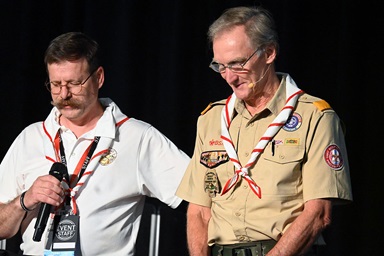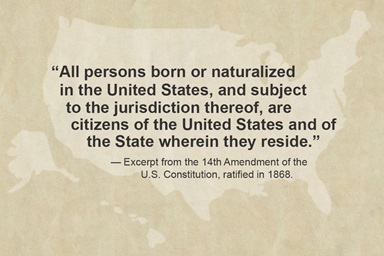Two United Methodists have taken an idea for bringing light to people living in darkness from their church altar to the White House in less than a year.
Doug McNeil and Jesse Salem — both members of Los Gatos United Methodist Church in California’s Silicon Valley — are being honored Friday, April 5, at the White House for founding Lighting for Literacy.
The program is a partnership between the church and Los Gatos Morning Rotary. It brings together youth and solar energy to address a real need — illuminating the night for people who lack electricity.
The April 5 festivities are part of the second annual Rotary Day at the White House. McNeil, a member of Los Gatos Morning Rotary, will be among 12 Rotarians recognized as “Champions of Change.”
McNeil said Lighting for Literacy enables youth to build technology that helps spread literacy and education around the world.
“It’s about helping other people,” he said. “It’s not just helping your neighbor but (also) people in other parts of the world that I will likely never meet. I think that’s doing God’s work.”
A problem with a green solution
It all started around Earth Day last April.
McNeil was looking for a Rotary project that would teach youth science, sustainability and “service above self,” Rotary International’s slogan. Salem had a problem that needed a scientific solution.
For the past 10 years, Salem had joined Los Gatos United Methodist Church's Volunteers in Mission in building homes in Colonet, a struggling, rural community in Mexico's Baja Peninsula.
Colonet is off the electrical grid.
Salem heard of homes in the Colonet area destroyed by fires ignited by kerosene lamps. One of the families whose home church members had built told Salem that their three daughters did their homework each night by candlelight.
"When you do a VIM project, you develop friendships," Salem said. "These three little girls were my friends, and I wanted to see them grow and do well."
That family has since moved from Colonet to a home with electricity, but Salem knew many others still went without.
More than 1.2 billion people - 20 percent of the world's population - are still without access to electricity worldwide, McNeil said, quoting 2011 figures from the World Bank. Those numbers include about 550 million people in Africa, and more than 400 million in India.
"In large parts of the world, when the sun goes down, people lose the opportunity to read and write by anything but kerosene or candlelight," McNeil said.
Kerosene, he noted, is expensive as well as flammable and potentially toxic.
McNeil and Salem, both engineers, met through a mutual friend at church. They wanted to figure out a way to brighten people's lives relatively inexpensively and safely. The two decided they needed light-emitting diodes, better known as LED, powered by the sun.
How it works
Salem came up with the design for the solar kit, McNeil said. The kits include a 12-volt battery, a solar panel, a charge-control circuit and an LED strip - all of which are readily available at area hardware stores.
United Methodist teachings on sustainability
From the 2012 Book of Discipline, which outlines the denomination's law and doctrines:
- Energy Resources Utilization, which asserts "We strongly advocate for the priority of the development of renewable energies."
From the 2012 Book of Resolutions, the denomination's statements on social issues:
- Environmental Justice for a Sustainable Future, which says: "Development must be centered in the concept of sustainability as defined by the World Commission of Environment and Development: 'to meet the needs of the present without compromising the ability of future generations to meet their own needs.'"
Green for Life
- See ways United Methodists are committing to be better caretakers of God's creation on this special coverage page.
"With those four components, we can light a room to the equivalent of a 60-watt (compact fluorescent) light bulb," McNeil said.
The solar kits could provide four hours a night and go up to three days in cloudy weather. The total price tag for the equipment was around $150.
To make the kits, Salem and McNeil first collected a special offering from Los Gatos United Methodist Church, which has a weekly attendance of about 250 people. Much of the financial support came from the Rotary club.
The church supplied the youth. Each youth is paired with an adult mentor, as they assemble a solar kit.
McNeil put together a 32-page instruction book to help guide the youth. He had an eighth-grader edit the booklet to make sure it was readable to non-engineers.
Building a solar kit can take up to four two-hour sessions, said Anthony Fatta, the church's youth director and one of the program mentors. He stressed that a person does not have to be an engineer to construct the technology.
Currently, 10 youth - from students in the fifth grade through high school - participate in the program. They include six church members and four students from the neighboring public school.
Fatta, a United Methodist clergy candidate, said in addition to the scientific principles that make the solar kits work, he hopes the youth also learn a theological lesson.
"This is a reminder that we are called to be co-creators with God," he said. "In a very literal way, we are bringing light where there has been darkness."
Enlightening impact
The Rev. Jennifer Murdock, the senior pastor of Los Gatos United Methodist Church, said when McNeil and Salem first approached her with the idea for Lighting for Literacy, they expected to have solar kits completed in six weeks - in time for the church's next mission trip to Colonet.
"I thought they were crazy," Murdock said. "I thought, 'We can't get the money for this. We can't get people committed to doing this.' I am so glad I was wrong."
During last year's trip, three youth installed five solar lights.
Since that first trip to Mexico, McNeil connected with a Rotary club in Bangalore, India, that used one of the program's solar kits to illuminate a local orphanage. Now, about 80 youngsters are using that light to study and read at night, McNeil said.
As soon as McNeil and Salem complete their visit to Washington, they will fly to San Diego, where they will meet up with a caravan from the church heading to another mission trip to Colonet. This mission trip will include eight church members and four Rotarians. They will bring 10 completed solar kits to install. The kits now also include USB ports, where residents can charge up cell phones and a solar cell capable of powering six hours of light a night.
Already, other churches, Rotary clubs and schools are expressing an interest in getting involved in the program, Salem said. He sees the White House trip as a chance to help grow the program still further.
One youth who installed the program's first lights was Julia Loper. She said being involved in Lighting for Literacy has strengthened her love of science and introduced her to "amazing role models." She is now a first-year chemistry major at the University of California, Santa Barbara.
But most profound was seeing the impact on people's lives, she said. After installing one of the lights, she recalled being alone with the homeowner.
"I said, 'What do you think?' He said, 'It's beautiful,' and he started to cry," she said. "When else are you going to see that in life?"
*Hahn is a multimedia news reporter for United Methodist News Service.
News media contact: Heather Hahn, Nashville, Tenn., (615) 742-5470 or newsdesk@umcom.org.
Like what you're reading? Support the ministry of UM News! Your support ensures the latest denominational news, dynamic stories and informative articles will continue to connect our global community. Make a tax-deductible donation at ResourceUMC.org/GiveUMCom.




